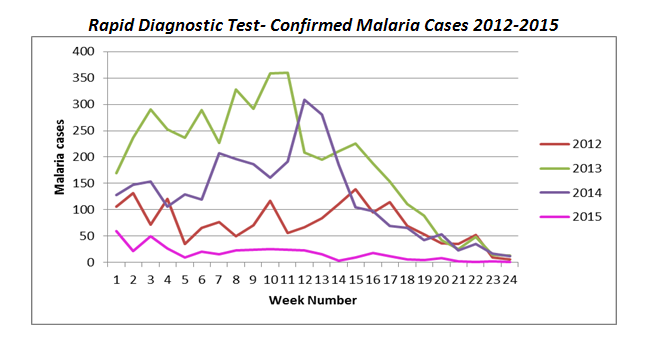
Rear Admiral Tim Ziemer, US Global Malaria Coordinator, discusses malaria cases at the Zindi clinic with the Provincial Medical Director for Manicaland.
In June 2015, Rear Admiral Tim Ziemer, U.S. Global Malaria Coordinator, visited Zimbabwe’s Mutasa District in Manicaland Province to see firsthand how entomological surveillance and monitoring can help to guide malaria prevention policies and programming, such as indoor residual spraying, in order to reduce the burden of malaria. At the PMI Africa Indoor Residual Spraying Project’s (AIRS) sentinel site at Zindi Clinic in Mutasa District, the Admiral along with Dr. Patron Mafaune, the Provincial Medical Director; Timothy Marevangepo, the District Environmental Health Officer; two PMI AIRS staff and others from PMI Zimbabwe were briefed on the monthly entomological surveillance conducted at the site.
Entomological monitoring and surveillance at the sentinel site identified the primary malaria vector, Anopheles funestus, in Mutasa District, and revealed the vector’s high level of resistance to pyrethroids, a type of insecticide. This finding led the Government of Zimbabwe to switch from the previously-used pyrethroid insecticide to an organophosphate (OP) insecticide for its 2015 spray campaign. The continued entomological monitoring has shown that the OP insecticide is reducing vector densities. Female Anopheles mosquito collections dropped from an average five vectors per room and two per window trap to zero vectors two weeks after spraying with OP. As of June 2015, no vector mosquitoes have been caught using standard sampling methods.
Sabina Chiwara, the Nurse-in-Charge at Zindi Clinic, said that since OP insecticide has been introduced, the malaria burden in the catchment area has decreased. The average rapid diagnostic test-confirmed malaria cases have shown a comparatively low number of malaria cases recorded during the first 24 weeks of 2015 compared to the same period the previous three years. The reported reduction of cases ranges from 77% to 91% from 2012 to 2015.

